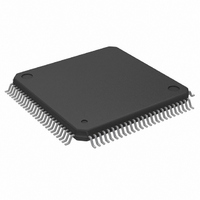Z8038018FSG Zilog, Z8038018FSG Datasheet - Page 37

Z8038018FSG
Manufacturer Part Number
Z8038018FSG
Description
IC 16 BIT Z80 MPU 100-QFP
Manufacturer
Zilog
Specifications of Z8038018FSG
Processor Type
Z380
Features
16-Bit, High-Performance Enhanced Z80 CPU
Speed
18MHz
Voltage
5V
Mounting Type
Surface Mount
Package / Case
100-QFP
Processor Series
Z80380x
Core
Z380
Program Memory Size
64 KB
Maximum Clock Frequency
18 MHz
Operating Supply Voltage
0 V to 5 V
Mounting Style
SMD/SMT
Lead Free Status / RoHS Status
Lead free / RoHS Compliant
Available stocks
Company
Part Number
Manufacturer
Quantity
Price
Z380 Microprocessor
Product Specification
Requests
A request can be initiated by a device that does not have control of the bus. Two types of
request can occur: Bus request and Interrupt request. When an interrupt or bus request is
made, it is answered by the CPU according to its type. For an interrupt request, the CPU
initiates an interrupt acknowledge transaction and for bus requests, the CPU enters the bus
disconnect state, relinquishes the bus, and activates an Acknowledge signal.
BUS Requests
To generate transactions on the bus, a potential bus master (such as a DMA controller)
must gain control of the bus by making a bus request. A bus request is initiated by driving
/BREQ Low. Several bus requesters may be wired-OR to the /BREQ pin; priorities are
resolved externally to the CPU, usually by a priority daisy chain.
The asynchronous /BREQ signal generates an internal /BUSREQ, which is synchronous.
If the /BREQ is active at the beginning of any transaction, the internal /BUSREQ causes
the /BACK signal to be asserted after the current transaction is completed. The Z380 MPU
then enters the Bus Disconnect state and gives up control of the bus. All Z380 MPU con-
trol signals, except /BACK, /MI and /INTAK are tri-stated. Note that release of the bus
may be inhibited under program control to allow the Z380 MPU exclusive access to a
shared resource; this is controlled by the SETC LCK and RESC LCK instructions. Entry
into the Bus Disconnect state is shown in Figure 26. The Z380 MPU regains control of the
bus after /BREQ is deasserted. This is shown in Figure 27.
Interrupt Requests
The Z380 MPU supports two types of interrupt requests, maskable /INT3-INT0 and non-
maskable (/NMI). The interrupt request line of a device that is capable of generating an
interrupt can be tied to either /NMI or one of the maskable interrupt request lines, and sev-
eral devices can be connected to one interrupt request line with the devices arranged in a
priority daisy chain. However, because of the need for Z80 family peripheral devices to
see the RETI instruction, only one daisy chain of Z80-family peripherals can be used. The
Z380 MPU handles maskable and nonmaskable interrupt requests somewhat differently,
as follows:
Any High-to-Low transition on the /NMI input is asynchronously edge-detected, and the
internal NMI latch is set. At the beginning of the last clock cycle in the last internal
machine cycle of any instruction, the maskable interrupts are sampled along with the state
of the NMI latch.
If an enabled maskable interrupt is requested, at the next possible time (the next rising
edge of IOCLK) an interrupt acknowledge transaction is generated to fetch the interrupt-
vector from the interrupting device.For a nonmaskable interrupt, no interrupt acknowledge
transaction is generated; the NMI service routine always starts at address 00000066H.
Page 37 of 125
PS010002-0708

















